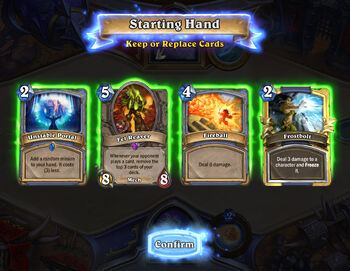- For the 2017 mini-series, see Hearthstone: Mulligans.

The mulligan stage
The mulligan, or card selection stage, is a stage at the start of each match in which both players have the ability to replace cards in their starting hand with random ones from their deck.
The term mulligan may also refer to the act of wishing for certain cards in the starting hand, such as in the phrase "mulliganing for", or the act of rejecting cards in order to draw replacements, such as in the phrase "mulliganing away".
Overview[]
The mulligan takes place following the introduction of each player, with the announcement of their hero names.
The mulligan stage begins with each player being given a random selection of cards, 3 cards for the player going first and 4 cards for the player going second. Both players have 65 seconds to mark as many cards as they like to be replaced with new cards from their deck. Note that such cards which are mulliganed away are not added back into the pool for possible replacements.[1] If only one copy of the card is in the deck, it is impossible to draw it as a replacement.
During the mulligan, the player is able to see the opponent's name and class in the top-left corner to assist them with their mulligan choices. Once both players have finalized their selections and clicked the redraw button, or the 65 seconds has elapsed, all marked cards will be replaced with new ones for both players, and their new starting hands will be shown to them. After both players finish the mulligan, a trained eye or a deck tracker can spot the number and position of cards which were mulliganed away from the opponent's hand.
Afterwards, the second player is also given The Coin as compensation for going second, and then the first turn begins.
The mulligan is a tactically significant stage, with each player attempting to draw the best possible cards for their starting hand based upon not only their own deck, but also the class and player against which they have been matched. A strong mulligan can make a significant contribution to a player's likelihood of winning the match.
Notes[]
- In-hand effects are active on cards during the mulligan. This allows players to correctly anticipate starting conditions for the cards in their hand. For example, if the starting hand of the player going second includes a
Mountain Giant, the Mountain Giant will show a modified cost of 8 during the mulligan.[2] This suggests that
The Coin is already in the second player's hand during the mulligan, prior to the visual animation which generates the card.
- Replacement cards are selected from the top of the undrawn deck, and are thus the same cards that would have been drawn over the player's first few turns, prior to the reshuffle.[3] Because the cards are simply drawn from the deck, it is quite possible to replace a card and get a copy of the same card as a replacement, if multiples are in the deck. It is even possible, though unlikely, to replace an entire hand and get all copies of those cards as replacements.
- Prior to the mulligan, the deck has already been randomly ordered. If the player chooses to replace any cards, the deck (including the replaced cards) will be shuffled (randomised) once the mulligan is complete.[4][3]
- Replaced cards are shuffled back into the deck after the mulligan is complete, ready to be drawn during the match. It is therefore possible to draw a mulliganed card at any point in the game with equal probability, including the very first draw of the game on turn 1.
- The opponent's hand is faded slightly during the mulligan, but it is still possible to observe their actions to a limited degree:
- A card back will highlight when the opponent hovers over the corresponding card, just as during the main game, but only if the opponent has not yet redrawn their cards.
- There is no indication of how many cards the opponent has marked for redraw, nor any sign of whether the opponent is still selecting or finished, before both players are finished.
- Once both players have submitted their selections, an animation shows which of the opponent's cards were replaced (how many and which hand position they were in). Only the backs of the cards are visible through the whole process.
- The mulligan in full lasts 75 seconds,[5] however, 10 seconds are spent on the intro cutscene, leaving only 65 seconds for the player to inspect their cards and act. Out of those 65 seconds, 5 seconds elapse before the cards become selectable (gaining green outlines).[6]
- With the release of Journey to Un'Goro, Quest cards are the only cards which interact directly with the mulligan phase, as they are guaranteed to appear in your mulligan.
Strategy[]
- See also: Mana curve
The mulligan is the only way players have to look for desired cards for their starting hands, and as such is very important to starting the game well and creating the greatest chance of success.
Generally, low-cost drops playable in the early game are preferred, while expensive cards that will be unplayable for many turns are replaced in favor of more options in the beginning. However, a particularly good card may justify the risk of running out of options in the first few turns. Sometimes an expensive card critical to a deck's win condition may be kept simply to ensure it does not end up at the bottom of the deck.
Mulligan objectives vary by format, deck type, and opponent:
- In Arena games, following the mana curve is very important since decks are unlikely to have many catch-up mechanisms, so players usually look for low cost drops to avoid falling behind.
- Aggro decks typically look for the most aggressive start possible with their mulligans since they rely on killing the opponent before they can mount a defense.
- With Control decks, the early focus is on not dying to early aggression, so the mulligan may be used for this purpose. In addition, key cards may be searched for to ensure they are available later, particularly if the deck has a strict win condition.
- The mulligan can be used to look for cards to beat the opponent's predicted play, based on the metagame surrounding the opponent's class. The opponent's class (and rank, when playing on the constructed ladder) is revealed before and during the mulligan.
The starting hand becomes less important the more cards are drawn, since the chance of having drawn any given card increases as more and more of the deck is accessed. For instance, the first player only has 5 cards on turn 2, so the mulligan increases the chance of having a preferred 2-drop from 31.0% to 45.8%. However, by turn 5, the player already would have a 46.9% chance of having drawn a given card, and the mulligan only increases it only slightly. The mulligan is therefore less crucial for a deck with many "catch-up mechanisms" that allow it to overcome an early disadvantage.
History[]
Before the release of One Night in Karazhan, it was possible to observe the number of cards mulliganed by the opponent before confirming one's own selection. This allowed some assessment of the opponent's starting hand and an appropriate response. For instance, if the opponent replaced one or zero cards, they may have an excellent starting hand, so spells useful against 2- and 3- drops might be kept. On the other hand, if the opponent replaced their entire hand, anti-early-game spells might be mulliganed in favor of drops that are independently good.
The animation of the opponent's redrawing was only shown if the opponent actually confirmed selection before the player did. Therefore, to avoid revealing any information to the opponent, sometimes players would engage in mulligan "standoffs" where both waited until the last possible moment to confirm their mulligans. Players and developers discussed changing the system to prevent these long waits, but for a time it was not considered a high priority issue since it typically only occurred in high level competitive play.[7] However, the change was made in Karazhan to show mulligan animations simultaneously, thus removing any reason to delay confirming the mulligan, and preventing any more standoffs.
Patch changes[]
 Patch 6.0.0.13921 (2016-08-09): Players can no longer see the opponent's mulligan until they lock in their own selection.
Patch 6.0.0.13921 (2016-08-09): Players can no longer see the opponent's mulligan until they lock in their own selection.
References[]
- ↑ Ben Brode on Twitter. (2014-11-25).
- ↑ http://imgur.com/7Fj9q5I
- ↑ 3.0 3.1 Ben Brode on Twitter. (2016-01-25).
- ↑ Ben Brode on Twitter. (2015-01-20).
- ↑ 75 is the value of TIMEOUT in the log file.
- ↑ https://www.youtube.com/watch?v=0lDFzFhLm3g
- ↑ Ben Brode on Twitter. (2015-03-25).
